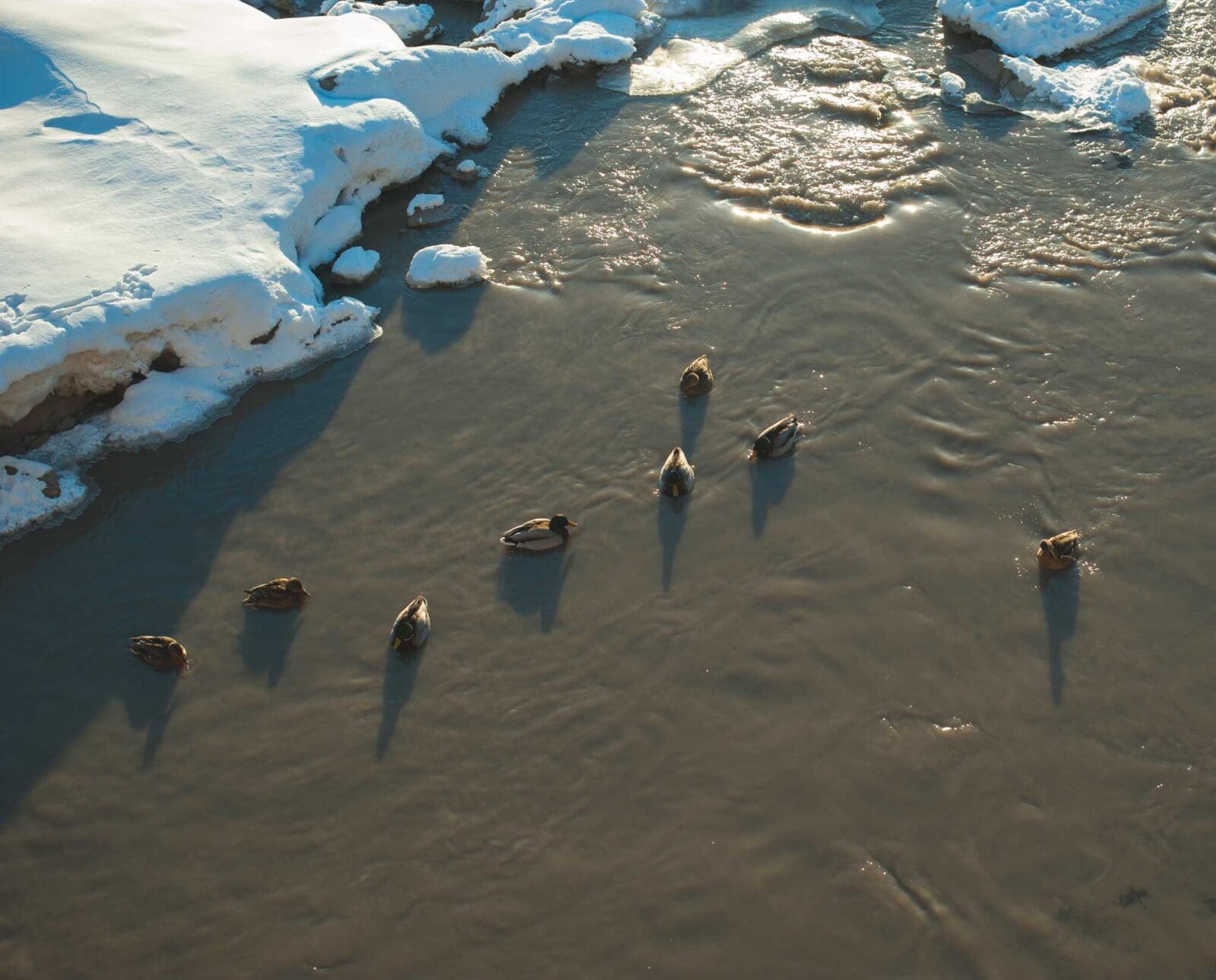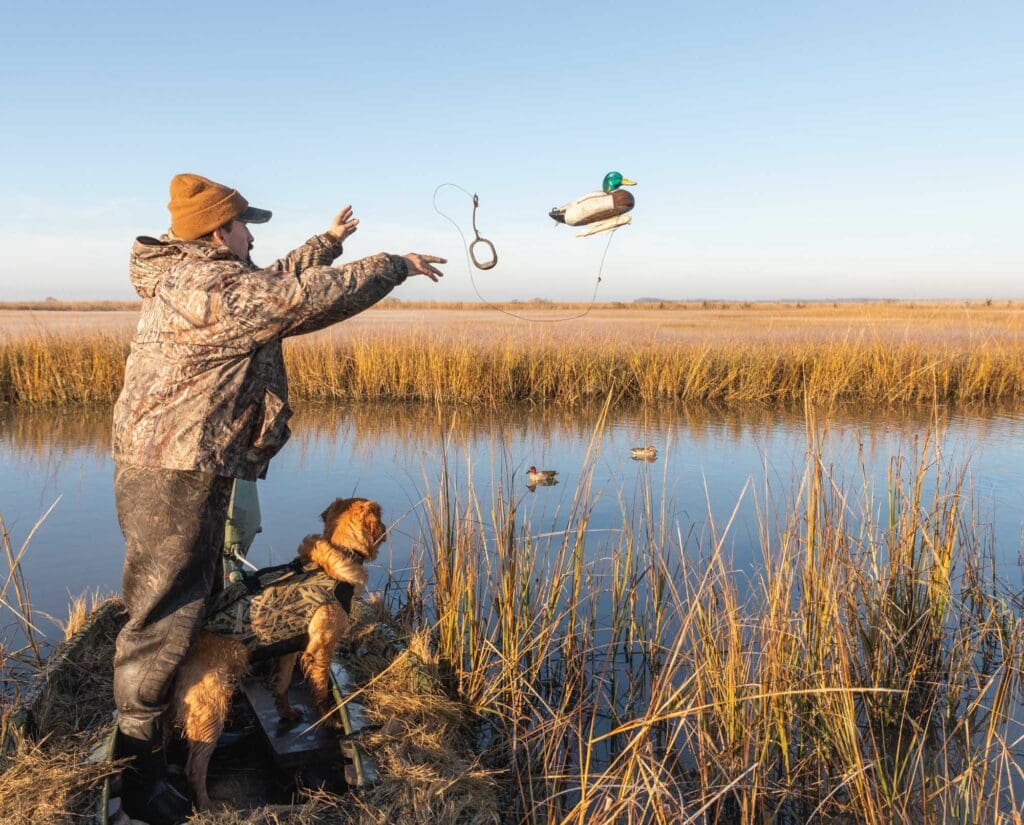Home » Waterfowl Hunting » Understanding Natural Duck Decoy Spreads
Understanding Natural Duck Decoy Spreads

Mike Adams is an outdoor writer, wildlife biologist, and educator…
Look to nature and replicate natural duck spreads with your decoys
Late-season ducks are veterans. These birds can pick out off-tone calls from a mile away. They’ve been shot at all season long. Survivors can tell steel shot from bismuth; some buddies wear pellets in their down feathers. Experienced ducks know every trick in the book and can’t be fooled by traditional means. To find success, duck hunters must be crafty. Luckily, even the most tenured of birds have an Achilles heel.
No matter how much they’ve been shot at, how many hunters they’ve busted, or how long they’ve been wintering on the same marsh, all ducks, year after year and generation after generation, hang around other ducks. That’s why duck hunters use decoys.
Nowadays, waterfowlers have all sorts of options when it comes to decoy spreads. There are cork, plastic, and wooden decoys. There are shells on pegs and silhouettes stamped out of plywood. Electric spinning wings and butt-up feeders are also available on the market. You can even buy inflatable decoys that you blow up like pool toys. All those choices can make selecting a decoy spread daunting, but cues from nature provide a cheat sheet. By studying the marshes, ponds, and lakes we hunt and the ducks in them, we can know what to do with our decoys in any given situation.
Study duck behavior and replicate it in your decoy spread
In January 2016, I learned the importance of becoming a good duck naturalist during a frigid hunt. The mercury dropped below zero, and my local tidal streams froze. Ducks pooled into the few open areas that remained. I set up my decoys in an unfrozen, fast-flowing ditch rimmed with ice. Although plenty of birds had checked me out by mid-morning, no ducks wanted what I had to offer.
To pass the time, I observed the ducks that failed to decoy. When the ducks landed elsewhere, they bound together in tight clumps. When ducks stooled into those clumps, they landed off to the side in singles, pairs, and trios. I analyzed the way they arranged themselves on the water. I dissected how the singles, pairs, and trios swam into the greater clump.
Noon rolled around, and I sat like a popsicle in an empty boat with a full box of shells. The gun hadn’t gone off once. So, I devised a plan. I motored out to my decoys and ripped them all out of the water. Then, I threw them back in; this time, I mimicked the ducks I had been studying all morning. I had a tight clump of a dozen dabblers, with a few pairs, singles, and trios fringing the edges. The big clump held tight to the bank. While the strays sat in the middle of the ditch as if they had just landed and were looking to join the flock. By sundown, the new spread turned a skunked hunt into a limit of black ducks and mallards.
Decoy spreads that attracted birds on opening day now signal danger. While famous decoy spreads like the J-hook and X spread have their time and place, odds are, the ducks you’re hunting aren’t used to seeing their friends laid out on the water like letters. If your quarry has previously fallen for the alphabet soup trick, they’ve probably been shot at. That’s why it’s essential to make late-season spreads replicate nature.
Unload your gun, hit the water with a pair of binoculars, and study duck behavior. What real ducks are doing may look like a pair of dabblers tucked close to the shoreline or a small flock of decoys mixed with Canada geese with a blue heron on the bank. Remember that duck behavior can change on any given day depending on weather, temperature, and relative hunting pressure; studying ducks frequently during the late season can put more ducks in your boat. If you mimic nature, knowledgeable ducks will have no reason to second guess your spread.

Replicate natural movement in your decoy spread
Although invitations from natural-looking spreads get ducks in the door, they may not get them to their seats. This is where movement comes in. Sometimes, a slight breeze is enough to breathe life into dead decoys. On windless days, you may need to break out a jerk rig. A jerk rig can turn buzzing wings into tight cups in an instant. Some hunters swear by spinning wing decoys, but for as much use as they may have in the early season, it’s worth packing those decoys up in a box and taping all the seams with a triple layer of duct tape when the birds get educated. Fake ducks that hover over decoys with perpetually beating wings create an alarm beacon for birds that know it’s hunting season. Once a duck gets blasted over a spinning wing decoy, it’ll never fall for that trick again.
Make movement happen, but keep it subtle. Let the breeze do the work for you when you can. When the wind howls and splashes white caps over your decoys, find a gentle cove and employ a jerk rig. Ducks don’t sit still on the water, and neither should your decoys. Even a little bit of natural movement can get veteran ducks to commit to your decoy spread.
Special considerations for your decoy spread
Ducks scrutinize decoy spreads like first-time home buyers. They want a well-built home in a neighborhood that’s cozy and safe. Educated birds look for species assortment and natural movement above all else. Get those two things right in your decoy spread, and you’ve built the foundation and tacked on the drywall. However, even if the roof has shingles and the insulation is set, your decoy house may lack that finishing touch. Furnish it with the proper duck decoy selection and confidence decoys like herons or geese, and ducks will be ready to move in.
Even novice waterfowlers know to select decoys based on the species they’re hunting. The concept seems simple when you skip past the mallard aisle for a sea duck hunt. However, it becomes a bit more nuanced when you consider duck behavior.
Along the mid-Atlantic, one can kayak down a tidal creek at low tide and flush a blimp-sized undulating ball of teal. On the other hand, when you paddle those same creeks and kick up black ducks, they flush in singles, pairs, and rarely more than a dozen at a time. When I throw out decoys in the mid-Atlantic, I’ll lean towards dense teal spreads and black duck spreads, with each decoy few and far between.
You can take your setup a step further by placing a few decoys outside your main assortment. I like to take a decoy or two and put them on the bank. Whether it’s a pond, stream, or tidal ditch, ducks will likely forage on the water’s edge. By putting a few right up on the bank, you mimic ducks feeding and add some trust to birds checking out your spread. The same strategy applies to traditional confidence decoys as well.
The concept of mimicking nature can be applied to any species. It gives birds the extra assuredness they need to close the final distance. Whichever way you arrange your decoys, make it natural and subtle. Late-season duck decoy spreads are all about giving ducks what they want to see.
Mike Adams is an outdoor writer, wildlife biologist, and educator hailing from salt marshes of the mid-Atlantic. His work has appeared in numerous outdoor publications, where he uses hunting and fishing narratives to explore deeper issues in conservation or ecology. In the fall, you'll find him on his Barnegat Bay Sneakbox hunting ducks with his dog, Boone. Any other time of year, he's usually out on the salt marsh, catching crabs or fishing for striper.



